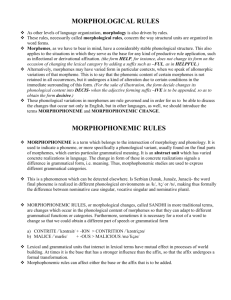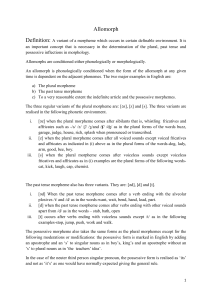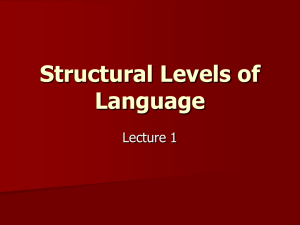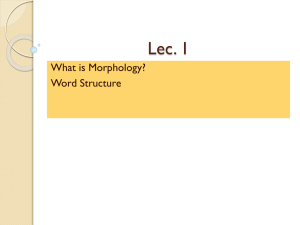Slide 1
advertisement
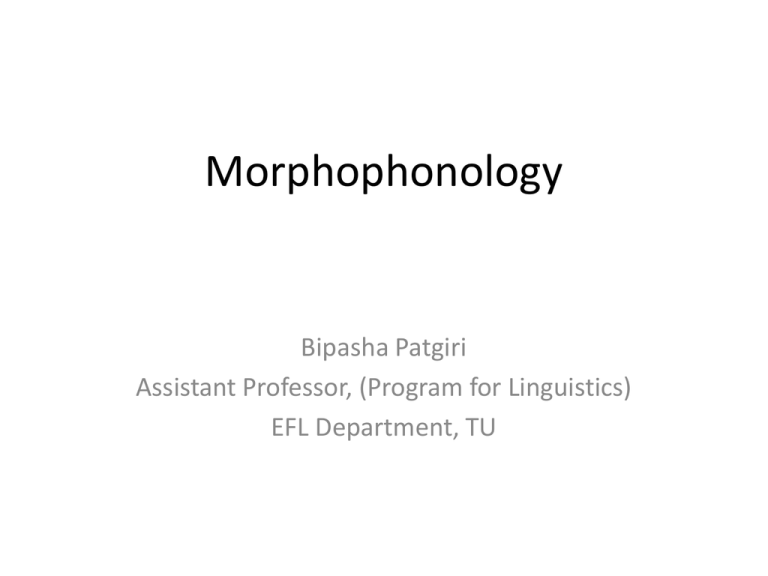
Morphophonology Bipasha Patgiri Assistant Professor, (Program for Linguistics) EFL Department, TU Introduction to Sub-fields of Linguistics • Phonetics: Study of sounds and their physical properties: Articulatory, Acoustic and Auditory • Phonology: Study of linguistically significant sound patterns. • Morphology: Study of word-formation processes. • Syntax: Study of sentence structure. Sub-fields of Linguistics (cont..) • Semantics: Study of meaning of linguistic expression. • Pragmatics: Study of contextual meaning of linguistic expressions. • Discourse analysis: Study of language in texts. • Semiotics: Study of signs and sign processes. Computational Linguistics • It refers to the study of linguistic issues in a way that is 'computationally responsible', i.e., taking careful note of computational consideration of algorithmic specification and computational complexity, so that the linguistic theories devised can be shown to exhibit certain desirable computational properties implementations. • It is an interdisciplinary field dealing with the statistical or rule-based modelling of natural language from a computational perspective. Some Interfaces of Linguistic Sub-fields • Phonetics and phonology are interrelated and both focus on the sounds used in human language. • Morphophonology: It deals with the phonetic alternations of phonemes/morphemes across morpheme boundary. • Morphosyntax: It deals with morphological alternations due to sentence formation. Morphophonology • It deals with the phonetic alternations of morphemes across morpheme boundary. • It is also termed as morphophonemics. • A morphophonemic rule has the form of a phonological rule, but is restricted to a particular morphological environment. • Morphophonemic variation occur at morpheme boundaries • And it involves sounds that are associated with separate phonemes. Morphophonology • A word’s pronunciation can be sensitive to morphological factors. For example, in English, ‘electric’ /elektrik/ (the final sound is a voiceless velar stop) but when added with an /-ity/ suffix, ‘electricity’ /elektrisity/ (the /k/ changes to /s/, a voiceless alveolar fricative) What is a Phoneme? • Phoneme is the smallest unit of sound. • Phonemes combine together to form morpheme or word. • For example, in English, the word ‘psychology’ is transcribed as /saikələʤi/ • And it consists of 9 phonemes. • Mind that, the spelling contains 10 symbols. • Spelling and pronunciation may not match in a language. What is a Phoneme? • Phoneme is the smallest unit of sound. • Phonemes combine together to form morpheme or word. • Find out how many phonemes are in the word ‘Ptolemy’ and ‘Christmas’ What is a Morpheme? • Morpheme is the minimal meaningful unit of word. • Morphemes combine to form words. • For example, in English, the word ‘disestablishment’ consists of 3 morphemes: dis-, establish and –ment • Out of these, only ‘establish’ can stand on its own. Rest, cannot. What is a Morpheme? • Morpheme is the minimal meaningful unit of word. • Morphemes combine to form words. • Find out the number of morphemes in ‘incapability’ and ‘antilogarithm’. Morphonology of English Plural Suffix • The selection of the correct form of the English plural suffix and the other involving plurals in which the final consonant of the root changes (as in thief-thieves). • [-s] tops mitts backs puffs batʰs /taps/ /mits/ /bɛks/ /pafs/ /batʰs/ Environment: The final sound of the base is a voiceless obstruent or non-strident (p, t, k, f, tʰ etc). • [-z] cobs lids bugs wifes pins wings peas days /kabz/ /lidz/ /bagz/ /waivz/ /pinz/ /wiŋz/ /piz/ /deiz/ Environment: The final sound of the base is vowel, diphthong or a voiced consonant. • [-əz] hisses buzzes judges wishes /hisəz/ /bʌzəz/ /ʤʌʤəz/ /wiʃəz/ Environment: The final sound of the base is a consonant that is strident (s, z, ʃ, ʒ, ʧ, ʤ) Plural allomorphy in English • State the distribution: • /-z/ [-s] occurs after a voiceless obstruent [-z] occurs a vowel, a diphthong or a voiced consonant [-əz] occurs after a strident Plural allomorphy in English • The choice of plural allomorph is determined by the final sound of the base word. • The underlying form is the one which happens to be at the widest distribution. • This process, in terms of phonological terminology, is called assimilation. The neighbouring segments assimilates to certain feature to become similar. Morphophonlogical rule • Definition: A morphophonemic rule has the form of a phonological rule, but is restricted to a particular morphological environment. • Discussion: Morphophonemic rules are sensitive to their environment, unlike phonological rules. Whenever morphological information is required to specify the environment for an allophonic rule, the rule is morphophonemic. English negative prefixation • The negative prefix /in-/ has the following allomorphs: /in-/ + respective = irrespective /in-/ + literate = illiterate Counter Examples • These rules are morphophonemic and not phonological. Because, if they were so, the prefixes /un-/ and /non-/ would also exhibit this pattern in the same way. But it is not so as • /un-/ + romantic = unromantic • /un-/ + limited = unlimited • /non-/ + resident = non-resident • /non-/ + lethal = nonlethal English negative prefixation • Hence, the morphophonemic rule which determines the allomorphs of prefix /in-/ to be [il-] and [ir-] is different from the rules which determine prefix forms of /un-/ and /non-/ prefixes. • Mind that, all these morphemes mean negation. English negative prefixation • The other allomorphs of English negative prefix: • Impossible • Intolerant • Incapable • Irresistible • Illegal English negative prefixation • More examples: English negative prefixation • State the distribution: English negative prefixation • State the rule:

